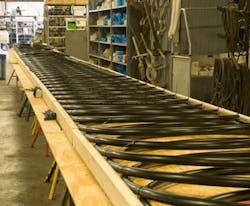Geothermal installation is educational process for contractors
PORT HURON, MICH. — At St. Clair County Community College here, contractors as well as college students are learning first hand about sustainable technologies and building via a geothermal installation underneath a large parking lot on campus and a YouTube video.
Just this August, on the first day of the fall semester, construction was completed on the geothermal system for the college’s North Building. The North Building is comprised of a 30,000-sq.ft., two-story classroom building with an adjacent 24,600-sq.-ft. upper level gymnasium and lower level locker room, complete with support classrooms and weight rooms.
The cost of the geothermal system along with resurfacing of the parking lots and construction of bioswales and rain gardens was approximately $4.3 million and was funded by the school’s millage income. The building, originally constructed in 1920, was served by two boiler systems, with one of those boiler systems targeted for replacement. The second remaining boiler continues to serve locker rooms and a gymnasium.
According to local newspaper reports, the college will save an estimated $52,000 per year for the North Building’s HVAC. That cost savings is based on the system reaching 30% savings on energy use over the pre-existing chiller and boiler system.
For this specific project, Ron Chapdelaine, project designer for Peter Basso Associates Inc., Troy, Mich., recommended a water-to-water heat pump manufactured by ClimaCool, a roof-mounted energy recovery unit made by Innovent, VAV boxes from Price and pumps from Bell and Gossett.
“The air-handle system selected for the building is plate-and-frame heat exchanger recovery units, roof-mounted with chilled water cooling coils and hot water heating coils capable of 100% economizer mode of operation,” said Chapdelaine. “The indoor units are variable air volume (VAV) boxes with hot water reheater coils within each room and CO2 sensors to monitor building occupancy outside air demand ventilation control.
“The existing system had a heat exchanger off of the existing boiler system and a cooling tower for the cooling side of the existing water-to-air heat pump system,” added Chapdelaine. “We looked at putting back similar equipment, but with the parking lots slated for replacement, it made sense to use a closed-loop ground source geothermal system.”
According to Chapdelaine, the geothermal system was based on a nominal 200-ton horizontal slinky field system located under the renovated parking lot. Normally, vertical wells would suffice for a geothermal project in Michigan, but the presence of a methane field forced another approach.
“We originally looked at a vertical well system, but due to methane gas pressures at around 30 PSIG only 50 feet below the ground in the city of Port Huron, it would not allow for a vertical well system,” said Chapdelaine.
Three fields were dug by Sopha Underground Maintenance of Port Huron, Mich., to a depth of eight feet and six inches, each being 615 feet long and 60 feet wide. In the three excavated pits a total of more than 30 miles of piping were used to construct the slinky loops.
Installing HDPE pipe
Not a stranger to geothermal piping installations, local contractor Watson Brothers Plumbing Heating & Air Conditioning, Port Huron, Mich., sought more information on installing a horizontal slinky system to boost productivity on the project. A consultation with Etna Supply, Chesterfield, Mich., the project’s pipe and fusion machine supplier, led to the sharing of a YouTube link. The link clued Watson Brothers into a smarter way for moving and packaging the 1-in. IPS high-density polyethylene coiled pipe for delivery to the jobsite in a manner that would ease installation.
Watson Brothers personnel watched the video, taking notes and then set forth to replicate the process. In the shop, workers set up a rig with 4-ft. x 8-ft. pieces of plywood with 2-in. x 4-in. pieces of wood attached at a 3-ft. distance, stretching the length of the rig. Together, the pieces of plywood were 45-ft. long. The 1-in. HDPE coil was delivered in 500-ft. coils.
The coil was designed to have a 10-in. overlap when unrolled on site, so corresponding 10-in. increments were marked off on the plywood. Workers unraveled the coil on the plywood, recoiling the loops to be 3-ft. wide. Once in place, the coils were zip-tied to stay in place.
“After assembly, we rolled the coil up into a ball that resembled a ‘big foot’ truck tire and tied it off with rope,” said David Dahnke, project manager for Watson Brothers. “This allowed us to roll the coil down into the field, cut the rope and unroll the slinky into place.”
The technique allowed Watson Brothers to haul six coil bundles to the site on a flatbed truck. The headers required for the slinky field were another critical component. Etna Supply’s Troy Taylor fabricated the headers at Etna’s Wixom, Mich., location.
Taylor fabricated 198 4-in. x 1-in. and 240 3-in. x 1-in. sidewall tees on the HDPE headers. The lengths of headers fused by Taylor were trucked to the site, sometimes on a daily basis.
For connecting the loops to the headers, Taylor recommended a new product, McElroy’s Socket Fusion Tooling Kit, featuring a MultiMc heater with microprocessor control and a dial thermometer to monitor heater temperature.
“Our guys like having the ability to dictate what the temperature of the heater is,” said Dahnke. “Our other socket tooling equipment didn’t afford us that luxury.”
By using a kit, Watson Brothers were provided heater adapters and tools specific to the size ranges commonly associated with geothermal installations.
